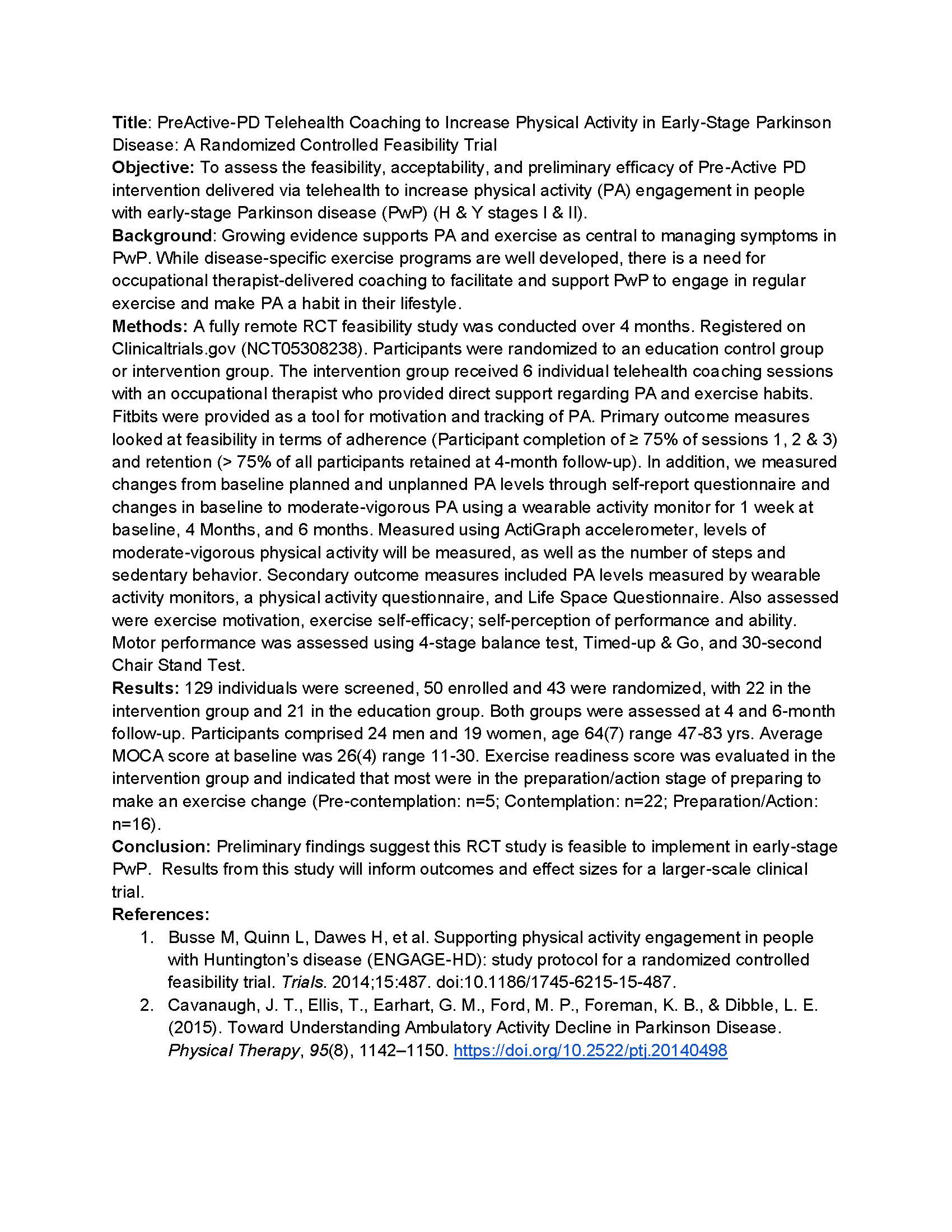Category: Allied Healthcare Professionals
Objective: To assess the feasibility/acceptability, and preliminary efficacy of Pre-Active PD intervention delivered via telehealth to increase physical activity (PA) engagement in people with early-stage Parkinson disease (PwP) (H & Y stages I & II).
Background: Evidence supports PA and exercise as central to managing symptoms in PwP. While disease-specific exercise programs are well developed, there is a need for occupational therapist-delivered coaching to support PwP to engage in regular exercise and make PA a lifestyle routine.
Method: A fully remote RCT(NCT05308238) feasibility study was conducted over 4 months. Participants were randomized to an education control group or intervention group. Intervention group received 6 individual telehealth coaching sessions with an occupational therapist who provided direct support regarding PA and exercise habits. Fitbits were provided as a tool for motivation and tracking of PA. Primary outcome measures looked at feasibility in terms of adherence (Participant completion of ≥ 75% of sessions 1, 2 & 3) and retention (> 75% retained at 4-month follow-up). In addition, we measured changes from baseline planned and unplanned PA levels through self-report and changes in baseline to moderate-vigorous PA using a wearable activity monitor. Measured using an accelerometer, levels of moderate-vigorous PA will be measured, as well as number of steps and sedentary behavior. Secondary outcome measures included exercise motivation, exercise self-efficacy; self-perception of performance/ability. Motor performance was assessed using 4-stage balance test, Timed-up & Go, and 30-second Chair Stand Test.
Results: 129 individuals were screened, 50 enrolled and 43 were randomized, with 22 in intervention group and 21 in education group. Both groups were assessed at 4 and 6-month follow-up. Participants comprised 24 men and 19 women, age 64(7) range 47-83 yrs. Average MOCA score at baseline was 26(4) range 11-30. Exercise readiness score was evaluated in intervention group and indicated that most were in preparation/action stage of preparing to make an exercise change (Pre-contemplation: n=5; Contemplation: n=22; Preparation/Action: n=16).
Conclusion: Preliminary findings suggest this RCT study is feasible to implement in early-stage PwP. Results from this study will inform outcomes and effect sizes for a larger-scale clinical trial.
Abstract
References: Busse M, Quinn L, Dawes H, et al. Supporting physical activity engagement in people with Huntington’s disease (ENGAGE-HD): study protocol for a randomized controlled feasibility trial. Trials. 2014;15:487. doi:10.1186/1745-6215-15-487.
Cavanaugh, J. T., Ellis, T., Earhart, G. M., Ford, M. P., Foreman, K. B., & Dibble, L. E. (2015). Toward Understanding Ambulatory Activity Decline in Parkinson Disease. Physical Therapy, 95(8), 1142–1150. https://doi.org/10.2522/ptj.20140498
Long, K. (2020). Pre-active PD: A therapist delivered physical activity behavior change program for people with early – stage Parkinson’s Disease. Available from ProQuest Dissertations & Theses Global. (2359437963). https://doi.org/10.7916/d8-d59j-tb74
Markland, D. & Tobin, V. A modification of the Behavioral Regulation in Exercise Questionnaire to include an assessment of amotivation. Journal of Sport and Exercise Psychology, 2004. 26:191-196.
Petzinger, G. M., Fisher, B. E., McEwen, S., Beeler, J. A., Walsh, J. P., & Jakowec, M. W. (2013). Exercise-enhanced neuroplasticity targeting motor and cognitive circuitry in Parkinson’s disease. Lancet Neurol, 12(7), 716–726. https://doi.org/10.1016/s1474-4422(13)70123-6
Quinn L, Trubey R, Gobat N, et al. Development and Delivery of a Physical Activity Intervention for People With Huntington Disease: Facilitating Translation to Clinical Practice. J Neurol Phys Ther. 2016;40(April):1-10. doi:10.1097/NPT.0000000000000119.
Quinn, L., Busse, M., Khalil, H., Richardson, S., Rosser, A., & Morris, H. (2010). Client and therapist views on exercise programmes for early-mid stage Parkinson’s disease and Huntington’s disease. Disability and Rehabilitation, 32(11), 917–928. https://doi.org/10.3109/09638280903362712
Quinn, L., Macpherson, C., Long, K., & Shah, H. (2020). Promoting Physical Activity via Telehealth in People With Parkinson Disease: The Path Forward After the COVID-19 Pandemic? Physical Therapy. https://doi.org/10.1093/ptj/pzaa128
Shih, H. S., Macpherson, C. E., King, M., Delaney, E., Gu, Y., Long, K., Reid, J., Fineman, J., Yu, G., Rieger, J., Satchidanand, A., Shah, H., Alcalay, R. N., & Quinn, L. (2022). Physical Activity Coaching via Telehealth for People With Parkinson Disease: A Cohort Study. Journal of Neurologic Physical Therapy: JNPT, 46(4), 240–250.
Wilson, P.M., Rodgers, W.M., Loitz, C.C., & Scime, G. “It’s who I am…really!” The importance of integrated regulation in exercise contexts. Journal of Biobehavioral Research. 2016. 11:79-104.
To cite this abstract in AMA style:
K. Long, A. Pacheco, L. Quinn, D. Wani, J. Alomar, D. Kipnis, C. Macpherson. PreActive-PD Telehealth Coaching to Increase Physical Activity in Early-Stage Parkinson Disease: A Randomized Controlled Feasibility Trial [abstract]. Mov Disord. 2024; 39 (suppl 1). https://www.mdsabstracts.org/abstract/preactive-pd-telehealth-coaching-to-increase-physical-activity-in-early-stage-parkinson-disease-a-randomized-controlled-feasibility-trial/. Accessed December 12, 2025.« Back to 2024 International Congress
MDS Abstracts - https://www.mdsabstracts.org/abstract/preactive-pd-telehealth-coaching-to-increase-physical-activity-in-early-stage-parkinson-disease-a-randomized-controlled-feasibility-trial/

